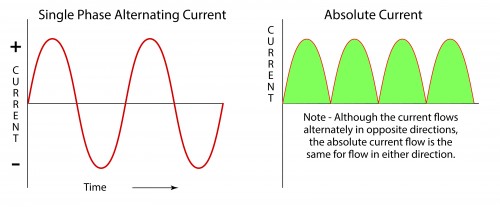Three phase power is commonly used where large amounts of electrical power are required. Examples are power transmission lines and large industrial machines which require considerable power. What is three phase power anyway?
Let’s start by thinking of a two wire transmission line as shown below connecting the source of alternating current power to the location where it will be used.
The amount of power that can be delivered to the destination is limited by the size of the wires and the distance. Now let’s say that there is a need to double the amount of power transmitted from the source to the destination. There are a few simple ways to do this. The first, and maybe most obvious, would be to add two more wires thereby duplicating the capacity of the single transmission line. Or, the size of the wire could be increased to accommodate more amperage without an increased loss of voltage at the destination. Or a transformer could be used at the source to increase the voltage (and lower the current in the transmission line) and a second transformer at the destination to reduce the voltage to that required. This option, of course, would require insulators with increased capacity along the transmission line to prevent additional losses. Larger wire and/or transformers and insulators are costly but feasible in some instances.
Note – A previous blog discussed the fact that wire is limited in its capacity to conduct amps but that increased voltage doesn’t matter as long as the wire is adequately insulated.
But there is another practical option which is why the following illustration looks much more familiar to us than the one above.
When one looks at the current in a single phase circuit, it can be seen that the full current carrying capacity of the wires is not utilized at all times. In fact, at some points in time the wire is not carrying any current (or voltage) at all.
With only two wires, there is no way to more fully utilize their current carrying capacity for more of the time. Adding a third wire, however, offers the opportunity to capture this unused capacity as shown below.

With 3 phase power, there are 3 alternating current sources (one between any 2 of the 3 wires). Each is out of sync (phase) with the other two by 1/3 of the 60 cycle frequency. This asynchronous scheme allows each wire to do “multiple duty” contributing to each of the phases during different parts of the cycle. The added efficiency is such that by increasing the number of wires by 50 percent (from 2 to 3) provides a 73 percent increase in power transmission capability using wires of the same capacity and with the same voltage delivered on each phase compared to that of a single phase. Because of this increased utilization of the wires’ capacity and the fact that three phase power is usually available at higher voltages than single phase power, three phase power is favored wherever large amounts of electricity are to be used or transmitted. Virtually all power transmission lines utilize the benefits of a three phase configuration and high voltage to transmit power over long distances with maximum efficiency which is why we see groups of three wires littering the countryside.
– FJF –



 English
English Spanish
Spanish Chinese
Chinese Canada
Canada Mexico
Mexico United Kingdom
United Kingdom






